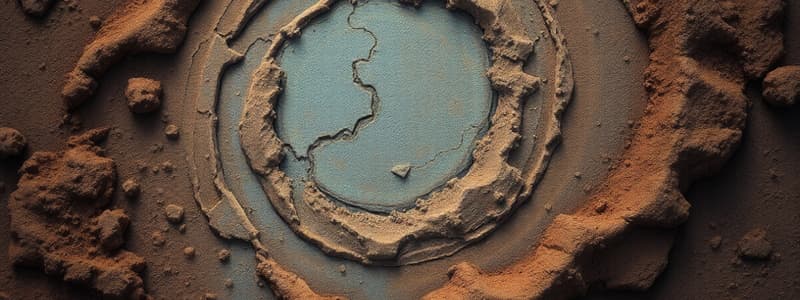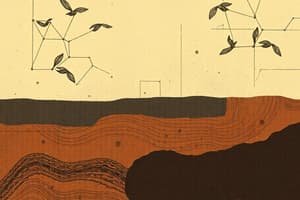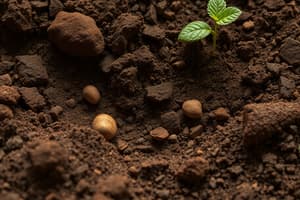Podcast
Questions and Answers
What is the average thickness of the topsoil layer, as indicated in the text?
What is the average thickness of the topsoil layer, as indicated in the text?
30 cm
What are the main components that constitute soil?
What are the main components that constitute soil?
Rock debris, grains of sand and clay, pieces of plants and dead animals
What is the main purpose of granulometry of the soil, as mentioned in the text?
What is the main purpose of granulometry of the soil, as mentioned in the text?
To study the size of soil particles and their distribution
Besides argiles (clay), what are the two other main classes of soil generally considered in agronomy?
Besides argiles (clay), what are the two other main classes of soil generally considered in agronomy?
By which organization was the definition of 'terre végétale' (topsoil) redefined in France?
By which organization was the definition of 'terre végétale' (topsoil) redefined in France?
Since what year has there been a precise and objective definition of 'terre végétale' (topsoil) in France, according to the text?
Since what year has there been a precise and objective definition of 'terre végétale' (topsoil) in France, according to the text?
According to the standard mentioned (NF 4 44-551), what is the minimum percentage of organic matter that topsoil should contain?
According to the standard mentioned (NF 4 44-551), what is the minimum percentage of organic matter that topsoil should contain?
According to the standard mentioned (NF 4 44-551), name one thing that topsoil should not contain.
According to the standard mentioned (NF 4 44-551), name one thing that topsoil should not contain.
What does ETM stand for in the context of the standard related to topsoil composition?
What does ETM stand for in the context of the standard related to topsoil composition?
What pH value is associated with ideal soil, according to the text?
What pH value is associated with ideal soil, according to the text?
According to the composition of ideal soil, what percentage does 'sable' (sand) make up?
According to the composition of ideal soil, what percentage does 'sable' (sand) make up?
According to the composition of ideal soil, what percentage do 'éléments fins' (fine elements) make up?
According to the composition of ideal soil, what percentage do 'éléments fins' (fine elements) make up?
According to the composition of ideal soil, what percentage does 'humus' make up?
According to the composition of ideal soil, what percentage does 'humus' make up?
What broader subject is Valerie Riera a professor of?
What broader subject is Valerie Riera a professor of?
What specific field of study is applied to the profession, according to the text?
What specific field of study is applied to the profession, according to the text?
What are the 5 types of soil grain sizes described in the image?
What are the 5 types of soil grain sizes described in the image?
What is the purpose of identifying different types of soils, different granulometries and the texture of a soil?
What is the purpose of identifying different types of soils, different granulometries and the texture of a soil?
What are soils made of
What are soils made of
According to the standard mentioned (NF 4 44-551), what must a soils' micro-organism content do?
According to the standard mentioned (NF 4 44-551), what must a soils' micro-organism content do?
Flashcards
What is the soil?
What is the soil?
Superficial layer of the Earth, averaging 30 cm thick.
Soil composition
Soil composition
Rock debris, sand grains, clay, plant pieces, dead animals; air and water circulate.
What is granulometry?
What is granulometry?
Study of soil particle size and distribution.
Main soil classes
Main soil classes
Signup and view all the flashcards
Organic matter content in topsoil
Organic matter content in topsoil
Signup and view all the flashcards
Ideal soil pH
Ideal soil pH
Signup and view all the flashcards
Ideal soil composition
Ideal soil composition
Signup and view all the flashcards
Study Notes
- Objective: Identify the different types of soils, the different grain sizes and the texture of a soil.
Substrates
- The soil is what our feet rest on.
- Soil is like the skin of the Earth, a thin surface layer.
- Soil is a few centimeters to a few meters thick.
- On average, it is 30 cm thick.
- It is the upper layer of the earth's crust.
- Soil is composed of debris of rocks, grains of sand and clay, pieces of plants and dead animals.
- Between these elements, there is more or less space where air and water circulate and where a multitude of living beings live.
Soil Granulometry
- Granulometry aims to study the size of soil particles and their distribution.
- In France, rules concerning particles that are interesting for soil analysis are presented in a figure.
- In agronomy, the three main classes are clay, silt, and sand.
Composition of Topsoil (Regulations)
- The term topsoil has been redefined by AFNOR, the French standardization association, to give it a fair definition.
- The definition of topsoil has only been precise and attributed objectively since 2002.
- 2002 is the year when the first standard framing the commercialization of topsoil appeared.
- These standards for crops (NF 4 44-551) impose the following criteria:
- Must contain a minimum of 3% and a maximum of 15% of organic matter.
- Must not contain pathogens or parasites from weeds and all plants or animals.
- Microorganism content must comply with the imposed standard.
- Must be below the defined threshold in terms of ETM (Trace Metal Elements) content.
Composition
- The ideal soil consists of a pH of around 7.
- 65% sand
- 30% fine elements
- 5% humus
Studying That Suits You
Use AI to generate personalized quizzes and flashcards to suit your learning preferences.




